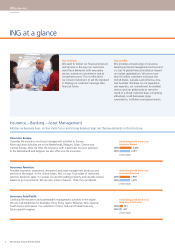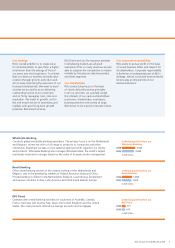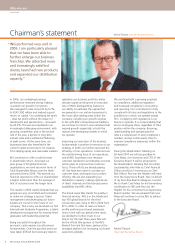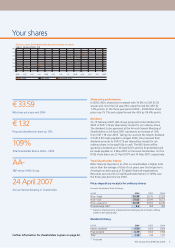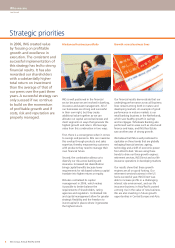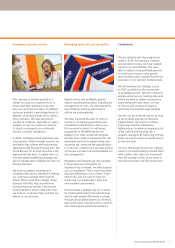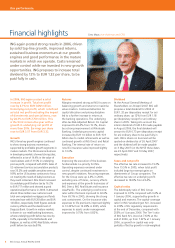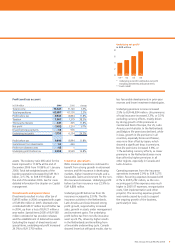ING Direct 2006 Annual Report Download - page 14
Download and view the complete annual report
Please find page 14 of the 2006 ING Direct annual report below. You can navigate through the pages in the report by either clicking on the pages listed below, or by using the keyword search tool below to find specific information within the annual report.
Faster approvals
Risk management
Our performance
continued
Risk management
Taking risk is inherent to our daily
business activities. To ensure prudent risk
taking throughout the organisation, we
manage risk through a comprehensive
risk framework, ensuring the proper
identifi cation, measurement and control
of risk at all levels. Important progress was
made in 2006 in strengthening the risk
management organisation and improving
risk modelling.
The overall Group risk profi le is measured
and reported to the Executive Board and
Supervisory Board on a quarterly basis by
means of a ‘risk dashboard’. The dashboard
includes the risks in all bank and insurance
lines of business and provides insight into
earnings at risk and capital at risk. The
dashboard allows the Executive Board to
better balance short-term profi t incentives
and long-term value objectives.
To strengthen the risk management
organisation the Executive Board has
appointed a deputy Chief Risk Offi cer
(CRO), who is responsible for risk
management and control on a consolidated
level. This change emphasises our
commitment to risk management and
our drive towards more effi cient risk
management. The Operational, Information
and Security risk functions have been
merged into one function, the head of
which reports directly to the deputy
CRO. The compliance function has been
transferred from the Legal department
to the Group Risk Function to further
improve the visibility and effectiveness of
Compliance. In addition a Model Validation
Unit has been established which validates
risk models. The head of this unit reports
directly to the deputy CRO.
Corporate Compliance
Financial institutions in general are coming
under closer scrutiny by society to ensure
they comply with laws, regulations,
standards and expectations. Bank regulators
and other supervisory authorities in the EU,
the US and elsewhere continue to scrutinise
payment processing and other transactions
under regulations governing such matters as
money-laundering, prohibited transactions
with countries subject to sanctions, and
bribery or other anti-corruption measures.
Regulators and other authorities have the
power to bring administrative or judicial
proceedings against ING, which could
result, amongst other things, in suspension
or revocation of ING’s licenses, cease and
desist orders, fi nes, civil penalties, criminal
penalties or other disciplinary action which
could materially harm ING’s results of
operations and fi nancial condition.
ING Bank N.V. has been in discussions
with its Dutch bank regulator De
Nederlandsche Bank (DNB) related to
transactions involving persons in countries
subject to sanctions by the EU, the United
States and other authorities. These
discussions prompted ING Bank N.V. to
engage in a review regarding transactions
involving sanctioned parties. In connection
with this review, which is ongoing, ING
Bank N.V. has been reporting to DNB and
it is not possible to predict at this time the
outcome thereof.
A priority for ING during 2006 has been
to increase compliance awareness Group-
wide and to implement the ING Group
Compliance Policy. In 2006, in the context
of changing legislation, regulation and
regulatory scrutiny ING revised, amongst
other policies, its Financial Economic Crime
Policy to comply with the third EU Anti-
Money Laundering directive and other
applicable laws and regulations.
Please read the Corporate Compliance
paragraph on page 207-208 of our
Annual Report for additional, important,
information on compliance.
Quantifying risk
During 2006 we continued refi ning
our capital models by means of an
enhancement and integration programme.
The completion of the full programme
is planned for 2007. This will include
insurance metrics and ensuring reporting
processes are effi cient, controllable and
auditable.
ING Group credit risk
Our aim is to maintain an internationally
diversifi ed loan, bond and investment
portfolio and to avoid large credit risk
concentrations. This is supported by a
system of risk limits that corresponds with
the risk appetite of the Executive Board.
Limits are set for countries, individual
borrowers, borrower groups and reinsurers,
which cascade down to all levels of the
organisation. The breakdown of our
portfolio in terms of credit risk ratings,
expressed in S&P rating equivalents,
is given in the table on page 13.
Due to the different nature of the insurance
and banking business the credit quality
of the ING Insurance portfolio is generally
higher than that of the Bank.
ING Bank market risk
Market risk in the banking books arises from
trading and non-trading activities. Our aim
is to measure, control and manage our
ING strives every day to
fi nd the optimal balance
between risk, return
and capital. In 2006, we
strengthened the Group Risk
function emphasising our
commitment to a sound risk
management organisation.
Risk management works with ING businesses
to help manage their commercial activities.
For example, a signatory system has been
introduced for credit approvals in Wholesale
Banking, replacing the lower-level traditional
credit committees. This has improved the
process for approving corporate loans. There
is more accountability, with one risk offi cer
and one frontline offi cer jointly signing for
acceptance of risk. It is also more effi cient,
resulting in a faster response to clients.
ING Group Annual Review 200612


